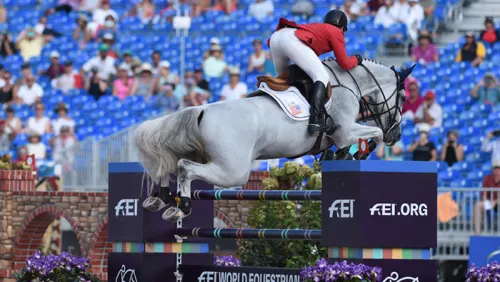On May 14, the Fédération Equestre Internationale published its updated list of eventing yellow (warning) card recipients online. Since April, two U.S. eventers have received yellow cards, and two have received verbal warnings.
At the Ocala Horse Properties CCI**/CCI* (Fla.), April 10-14, verbal warnings went to Leah Lang-Gluscic (abuse of horse—spur marks) and Hallie Coon (incorrect behavior—late for cross-country start).
Marilyn Little received a yellow card at the Rolex Kentucky CCI****, April 24-28, for “incorrect behavior—leaving the venue after a fall without submitting to the examination by Official Medical Officer” after she fell from RF Demeter on cross-country.
Alexandra Kalinich received a yellow card (dangerous riding—riding fence too fast) while competing in the CCI* at Ocala on her horse Ariel VI. “My horse was running out of control, and I just wasn’t fighting enough to get her back,” Kalinich said. “I was just going really fast and not setting my horse up for the jumps and just running at them. I went into the water, and my horse leaped off the bank, and I fell off.”
The 18-year-old, riding in her first one-star, admitted that the yellow card was handed out in a situation where it needed to be handed out, and she was happy with how president of the ground jury Christian Landolt (Switzerland) and member of the ground jury Marilyn Payne handled the situation.
“They explained the whole thing, and they said the whole reason they do this is to prevent someone from getting hurt. Cross-country is a dangerous thing,” she said. “I think once you actually get the yellow card and have to sign the paper and have to talk to the TD, it actually kind of sets people back, like, ‘Maybe I should listen to them.’ It was really educational, and I learned my lesson not to ride that dangerously. I put myself and my horse in a lot of danger.”
Payne, an FEI eventing judge and official, explained that at Ocala, cross-country control was stationed near fence 4, a combination, and they radioed to her that Kalinich looked too fast. “At the fourth fence, she was going too fast. She never prepared and balanced him before the fence. We kept monitoring her. I was driving on a golf cart to try to see as much of the course as I could,” Payne said.
By the time Kalinich reached the water jump towards the end of the course, resulting in her fall, Payne and Landolt decided to speak with her after her round.
ADVERTISEMENT
“In her case, there was another combination where she was riding too fast, but we didn’t feel the need to pull her up at that point. Sometimes they start out the course too fast because the horses are keen or they’re a little strong or the riders are excited, and they get going a little bit too fast by mistake. Usually they settle into a rhythm and improve during the course,” said Payne.
Payne explained that when deciding to give a yellow card, there are several considerations before approaching the rider. Stewards are usually situated in the warm-up to alert officials if they see a rider looking dangerous, nervous or a little too fast, while the help of the technical delegate, course designer and other officials is enlisted to help monitor riders on the course.
“First we talk to anyone that saw the problem. We talk to the jump judges and get their interpretation of what happened, then we talk to any other stewards and any other officials,” said Payne. “In this case, the jump judge was worried. Sometimes, as officials, we are not able to see all the fences on the course but get reports from the jump judges and officials.”
Next, the ground jury will ask the rider for their interpretation of the incident.
“Many times, the riders immediately go, ‘Oh my God, I can’t believe I made the mistake. I realize that; I am so sorry. I thought about that, but then I was so nervous, and I pushed the horse by mistake.’ They understand, and they realize they made a mistake before you even say anything. Then you’ll just talk to them and tell them you were worried about them, et cetera, and you won’t give them a yellow card,” Payne said.
While most riders accept their penalty, some simply don’t agree. “Sometimes the riders don’t have a clue. They don’t agree with you, they don’t understand, they don’t feel what everyone else saw. Some of them get a little belligerent, too,” she continued.
If possible, Payne likes to speak with the rider’s trainer too. “We always talk to the trainer. We try and be as objective as we can and ask all the officials, the trainer and the rider. We talk to everyone, because we want to know the real story, and then we want to try and educate the rider as best as we can. The thing is to educate riders and to make the sport safer. Nobody likes to give yellow cards,” she said. “Ever since this system started, giving the yellow cards and the dangerous riding penalties, it has dramatically changed the way riders ride. Now, if they have one or two stops, they’ll just retire. You don’t have to complete. It’s better to wait until another day.”














